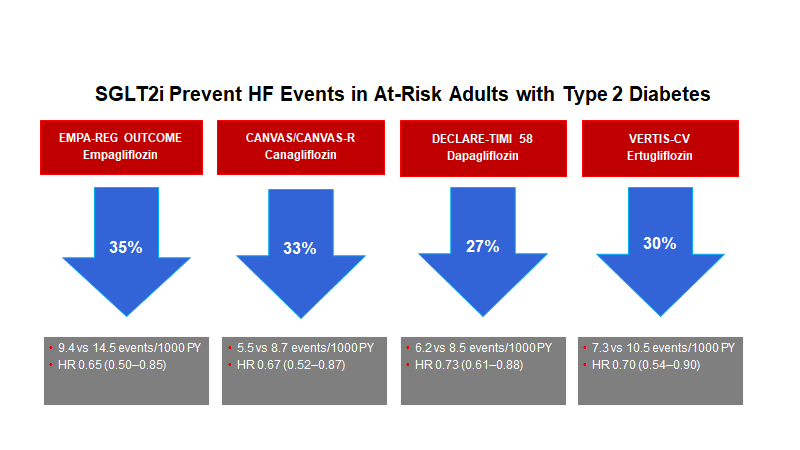
Join here tomorrow for the launch of a new accredited tweetorial on the expanding role of #SGLT2i in CV disease! Earn 0.5 CE/CME credits: physicians, nurses, pharmacists! Expert faculty @mvaduganathan. #medtwitter @academiccme #diabetesmanagement @endocrinenetwrk
1) Welcome to a Tweetorial on #SGLT2i & CV health. “Flozinators of the world, unite!” Accredited for 0.50h by @academiccme: #physicians, #nurses, #pharmacists. I am @mvaduganathan . . . 

. . . and this educational activity, which is intended for healthcare providers, is supported by grants from Abbott, AstraZeneca, Bayer, Chiesi, and NovoNordisk.
2) The sodium-glucose cotransporter-2 inhibitors (#SGLT2i) have been firmly established as a cornerstone in high-risk primary and secondary prevention of CV and kidney disease. After 10 large-scale #RCTs, the “-flozins” are one of the best studied cardio-renal-metabolic Rx.
3) Which of the following entities have #SGLT2i NOT been evaluated in large-scale outcomes trials?
4) The answer is choice 4. Three large-scale RCTs (#DAPAHF, #EMPERORReduced, #DAPACKD) have evaluated patients without T2D including prediabetes, however all required pts to have established #HF or #CKD.
5) SGLT2 transporters are predominantly expressed in the proximal tubule of the nephron. #SGLT2i inhibit the reabsorption of glucose (and sodium) here, a process that is upregulated in #T2D.
6) Although many are in various phases of development worldwide, there are 4 @US_FDA approved #SGLT2i (canagliflozin, dapagliflozin, empagliflozin, ertugliflozin). These compounds have variable selectivity for the kidney #SGLT2 and gut #SGLT1. Source PMID: 29042751 

7) The clinical significance of this transporter selectivity is yet to be established. In the 4 initial CV outcomes trials required by the @US_FDA to establish CV safety, which endpoint was most consistently reduced with #SGLT2i?
8) Mark your best answer and return tomorrow for the answer and more education! #FOAMed @KismetRasmu @pabeda1 @kidneyboy @DaveDixonPharmD @kamleshkhunti @NMHheartdoc @hvanspall @mirvatalasnag @djc795 @EiranGorodeski @AndrewJSauer @JohnRMontford @dr_benoy_n_shah @AnastasiaSMihai
9) Welcome back to our accredited tweetorial on #SGLT2i & CV health! I am @mvaduganathan - change CV fate & #flozinate. @CMichaelGibson @md_pollack @drkevinfernando @drricardocorrea @RpratleyMD @DLBHATTMD @cpcannon @CardioNerds @brendonneuen @JasonProsek
10) As to our poll from yesterday, #SGLT2i reduced risks of hospitalization for #HF by ~30% without heterogeneity by drug within class. More modest reductions in #ASCVD events were observed. 

11) In the 4 initial CV outcomes trials, #CV death was subject to the most heterogeneity, and was most evident in EMPA-REG OUTCOME (10.1056/NEJMoa1504720). Less is known about the exact modes of death that #SGLT2i protect against.
12) While *prevention* of HF in at-risk individuals with #T2D was established in initial RCTs, subsequent trials pursued whether #SGLT2i may be important in the *treatment* of HF, even among those without #T2D
13) Two large RCTs (#DAPAHF #EMPERORReduced) have shown consistent reductions in death & HF events among pts with HFrEF. Robust findings were irrespective of presence or absence of diabetes and background medical Rx. @FaiezZANNAD 

14) An additional RCT, #SOLOISTWHF, by @DLBHATTMD et al showed benefits of sotagliflozin when initiated before or shortly after hospital discharge for #WorseningHF. Concordant signals of benefits were observed across the LVEF spectrum, including in the sample with #HFpEF. #ACC21 

16) So how do #SGLT2i work in preventing & treating HF? While #SGLT2 transporters are not expressed in the myocardium, a number of #cardioprotective mechanisms have been proposed . . .
17) . . . Check out this #StateoftheArt review in @JACCJournals #OpenAccess by @ZelnikerThomas & #ProfBraunwald
pubmed.ncbi.nlm.nih.gov/32000955/
pubmed.ncbi.nlm.nih.gov/32000955/

18) In several carefully designed mechanistic evaluations (including by @SantosGallegoMD @matthewmylee @MassarOmard), #SGLT2i have been shown to promote favorable LV reverse remodeling. These benefits were observed in pts with and without T2D. 

19) Patients with HF treated with #SGLT2i may also experience improved hemodynamics and filling pressures, which may in turn be related to improved myocardial performance and/or direct decongestive effects. #EMBRACEHF by @MichaelNassifMD @MkosiborodMD
ahajournals.org/doi/10.1161/CI…
ahajournals.org/doi/10.1161/CI…

20) However, most patients in HF RCTs treated with an SGLT2i did not require changes in diuretic dosing. As such, anticipatory diuretic dose reduction is generally not needed for most
@Kieranfdocherty @PSJhund @UoGHeartFailure
@Kieranfdocherty @PSJhund @UoGHeartFailure

21) In HF, #SGLT2i have minimal BP lowering effects, especially among those who have low starting systemic BPs. academic.oup.com/eurheartj/arti… @Kieranfdocherty @PSJhund @UoGHeartFailure 

22) What is the most frequently observed adverse drug effect with #SGLT2i?
23) Cast your vote, return tomorrow, and receive a link for your CE/#CME credit after we wrap up this latest installment. #SGLT2i = the new ACEi of cardio-renal-metabolic disease. @Sglt2inhibitorL @ShasankSinha @VietHeartPA @mmamas1973 @AmitGoyalMD
• • •
Missing some Tweet in this thread? You can try to
force a refresh






